Mixed Economy: Definition, Pros, Cons & Examples
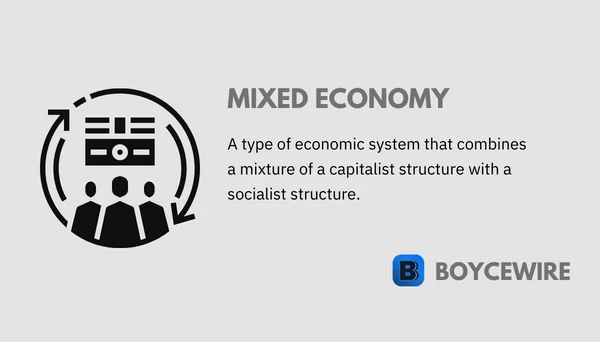
What is a Mixed Economy
A mixed economy is an economic system that combines elements of a capitalist, market-based system, with a socialist, command economy system. It mixes elements such as private property rights, free trade, and privatization, with socialist elements such as regulation, the welfare state, and re-distribution.
Most nations across the world operate under some form of mixed economy system. This can come in the form of a socialist economy which relies of private enterprise and ownership, but big government and high taxes – as is the case in Scandinavia. By contrast, a mixed economy may lean towards more free markets. For instance, Singapore relies largely on private enterprise, free trade, and low taxes. Yet its government still has significant ownership of housing and land, and controls many aspects of its people’s lives.
Key Points
- A mixed economy is a combination of a capitalist market-based system, and a socialist, command economic system.
- Most nations operate under a mixed economy system, although some lean towards a more socialist mix (China), whilst others to a more market-based mix (USA).
Characteristics of a Mixed Economy
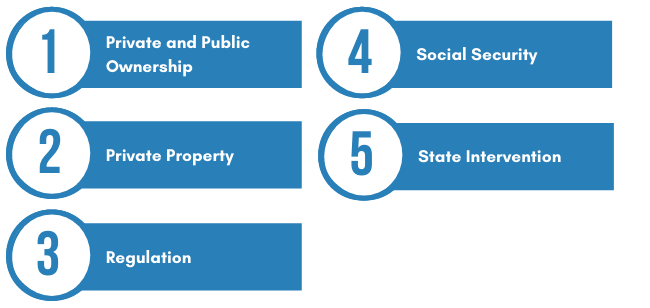
1. Private and Public Ownership
In a mixed economy, there is a mixture of both public and private ownership. In most nations today, it is largely skewed towards private ownership in the west – with small levels of public ownership. For instance, the UK operates a socialist healthcare system under the NHS, whilst the US also offers public medicine through Medicare and Medicaid, as well as its operation of the US postal service (USPS). Yet the majority of its economies are controlled by private enterprises.
If we now contrast this with nations such as China and India – the majority of their institutions are largely owned by the state. Yet there are a small number of private enterprises that operate independently – although these are in the minority. This contrasts with the west that has a more private based system, whilst China and India lean more towards a command economic system with public ownership.
2. Private Property
In a mixed economy, it will always have some element of private property and ownership – otherwise, it would be classified as a pure command economy, where resources are centralized. This simply means that individuals are able to claim ownership of their property – whether that is their house, car, or business.
Without the right to own private property, the economic system would be more representative of that of a socialist command system.
3. Regulation
In a market-based system, goods and services are freely sold without intervention by the government. That means there are no requirements to meet set quality standards dictated by the government. For instance, cars are required to have a seatbelt and an airbag as standard. However, a market-based system would not have such regulations.
A mixed economy allows for some markets to operate freely as they would do in a market-based system. However, in other markets, it regulates more fiercely in a similar way we would see under a command economy. For instance, the production of video games is largely unregulated, whilst the production of motor vehicles faces a large number of restrictions.
4. Social Security
The presence of social security is somewhat of a hybrid between a market system, where no support is provided, and a command economy, where income is solely provided by the government. By offering social security for the disabled, unemployed, and the elderly, society is being supported, but not to the same extent as a socialist system.
5. State Intervention
When firms fail, a market economy would allow them to go out of business. By contrast, a command economy would fully support it through the government. Under a mixed economy, some businesses will be allowed to go under, whilst others require some level of state intervention. This might come in the form of tariffs to fight international competition, or subsidies to help them survive financially.
Mixed Economy Advantages
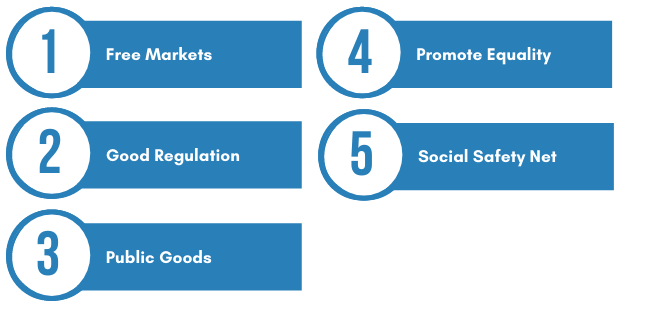
1. Free Markets
One of the advantages of a mixed economy is that it still relies on supply and demand to dictate prices. In the main, markets are allowed to react when there is an increase in demand – by raising prices and increasing supply. Or, when demand falls, prices and supply also fall. In turn, it allows the market to work efficiently by catering to the consumer’s demand.
Whilst a mixed economy does not allow for the same free rein that a market-based economy would – it still allows for free competition in a large number of markets, and significantly more than under a command system.
2. Good Regulation
This is up for interpretation, but on occasion, a mixed economy can provide sensible regulation. For instance, the US has the Federal Trade Commission’s Bureau of Competition that regulates anti-competitive practices. Its aim is to ensure that there is sufficient and fair competition in the marketplace – thereby maximizing choice for the customer and eliminating monopoly control.
There are also other antitrust laws that make certain forms of price discrimination illegal. For instance, charging an individual a different price based on a protected characteristic such as sex or race. The aim of which is to protect the customer from underhand tactics that business may use.
3. Public Goods
In a market-based system, it would be up to the free market to provide goods to consumers. However, some goods are unprofitable to provide, so the public is unable to benefit from them. For instance, public goods such as parks, libraries, and education all provide positive externalities. They may not provide a profit to the firm providing them, but the benefits to society outweigh the costs.
In a mixed economy, these public goods would be supplied by the government, thereby generating the positive externalities associated with them. For instance, education not only provides a benefit to the student but also society. Society benefits by having a more educated workforce, which allows employees to be more productive and efficient – thereby reducing the cost of goods and services.
4. Promote Equality
Mixed economy systems rely on the welfare state to maintain a balance between the rich and poor. This usually requires some form of taxation whereby the well off in society pay more to help subsidize those on low incomes. For instance, in the US, the top 1 percent of income earners pay roughly 35 percent of the nation’s income taxes. In turn, this income is used to pay for services such as Medicare and Medicaid – as well as housing benefits, unemployment benefits, and disability benefits.
5. Social Safety Net
Mixed economy systems offer some form of social safety net. This may come in the form of unemployment benefits, disability benefits, or a pension in old age. This grants income protection for those who may be unable to find work in unemployment, or, those who are unable to work due to old age or disability. In turn, those who are cannot find work or are unable to, can remain members of society, rather than go hungry and homeless.
Mixed Economy Disadvantages
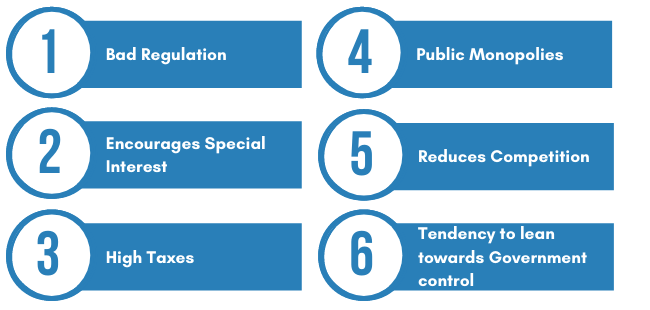
1. Bad Regulation
Although a mixed economy may produce some good regulations such as the anti-trust regulations, it has its fair share of bad ones. For instance, the US requires nearly one-third of workers to have an occupational license. This ranges from the hairdressers, to dance teachers, to dog walkers. In some states, to become a hairdresser, you must have a high school diploma, whilst you need a license to walk dogs.
2. Encourages Special Interest
When you have a mixture of government and private enterprise, it is inevitable that they will overlap. So when laws are made, private enterprises have an incentive to shape legislation to benefit them. As a result, we see a number of businesses lobbying the US congress in order to gain preferential treatment. This is only intensified when campaign contributions are on the table. If big businesses don’t get their way, then those contributions can easily move to the other party.
3. High Taxes
In a mixed economy, the size of government is much large than a market-based version. It has a greater emphasis on welfare spending and influencing the wider economy. So to pay for it, it requires quite high levels of taxation. These can range from relatively modest rates in Singapore to the very high rates in Scandinavia.
4. Public Monopolies
A mixed economy involves government influence and on occasion, this can mean taking over or controlling a sector of the market. For instance, in the US, the Federal government controls the postal service (USPS). In turn, it has a monopoly on the delivery of letters. It is illegal for any other firm to deliver letters – thereby granting it a monopoly.
In the same way as a private monopoly, a public monopoly has to compete and is not affected by the normal laws of supply and demand. At the same time, because it is controlled by the government, it doesn’t even need to make a profit – unlike a private monopoly. The result is a limited choice for consumers and higher prices.
5. Reduces Competition
A mixed economy is characterized by regulation and government interference in economic activities. By introducing regulatory requirements, additional costs are imposed on businesses. For instance, meeting environmental standards costs manufacturers millions of dollars each year. For those who are not as efficient, this can push them over into bankruptcy as they are unable to afford the cost of such regulations. What results are fewer competitors in the market, limited choice, and higher prices for consumers.
6. Tendency to lean towards Government control
Mixed economies are relatively new in the fact that most nations used to be either highly market-based or highly socialist – there was little in between. Yet since the Great Depression and the Second World War, the government has taken a forward step in its involvement in the economy. It is not only spending significantly more than it did previously but also regulating and controlling markets more intensively.
Mixed Economy Examples
United States of America
The United States of America is known as the shining star of free-market capitalism. Yet it is definitively a mixed economy. Its government spends close to 40 percent of GDP each year, whilst it operates a relatively robust tax regime that taxes income, capital, sales, housing, and inheritance – among many more. At the same time, it also has a large number of regulations. For instance, one in three jobs in the US requires an occupational license, whilst there are over 454 Federal agencies.
China
Although China leans more towards the socialist side, it does have elements of a market-based system. Since the death of its leader Mao Zedong in 1976, the nation turned towards a more market-based approach to revive its struggling economy. A number of market reforms followed, allowing citizens to start businesses, foreign direct investment, and its eventual incorporation into the World Trade Organization (WTO). In the years following, we have seen China flourish into a global superpower and continue to grow strongly.
Russia
Since the collapse of the Soviet Union in 1991, Russia went on to achieve high levels of sustained economic growth through the 2000s. As with many other countries, it was significantly affected by the 2008 financial crisis but recovered strongly after. Yet its desire for war has led to a number of economic sanctions against it.
Having previously opened its market up following the collapse of the Soviet Union, Russia benefited from trading with the West – particularly its oil. At the same time, it opened its markets up to private individuals to open their own businesses in a nod to a market-based system.
United Kingdom
Similarly to the US, the UK has been a proponent of free-markets throughout the years. It has a high degree of economic freedom in the fact that it has strong property rights and individuals can freely set up their own business. Those owners also face relatively little in the way of regulations – at least in comparison to some other developed nations.
On the other side, it operates a number of socialist-style policies. For instance, the government controls the National Health Service (NHS), its welfare state spends roughly 15 percent of GDP, and it controls live television (you need a license to watch, even if it’s on a non-government owned channel).
Related Topics
FAQs on Mixed Economy
Most countries across the world operate as a mixed economy. There are elements of a market-based system through free markets, free trade, and private enterprises, but there is also elements of socialism through public ownership, regulation, and taxation.
The US is a mixed economy because it has free market elements, property rights, and private ownership, but it also has socialist elements such as a welfare state, public ownership such as USPS, and Medicare and Medicaid.
A mixed economy is an economic system that combined elements of socialism and capitalism.
About Paul
Paul Boyce is an economics editor with over 10 years experience in the industry. Currently working as a consultant within the financial services sector, Paul is the CEO and chief editor of BoyceWire. He has written publications for FEE, the Mises Institute, and many others.

Further Reading
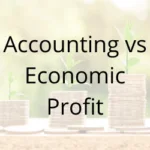 Accounting vs Economic Profit - The main difference between accounting and economic profit is that economic profit includes implicit costs. Whilst accounting profits include the…
Accounting vs Economic Profit - The main difference between accounting and economic profit is that economic profit includes implicit costs. Whilst accounting profits include the…  Capital Flight: Definition, Causes, Effects & Examples - Capital flight occurs when investors or businesses remove their money from a country.
Capital Flight: Definition, Causes, Effects & Examples - Capital flight occurs when investors or businesses remove their money from a country.  Production Function: How to Calculate with Formula & Example - The production function calculates how many inputs you need to create X number of outputs.
Production Function: How to Calculate with Formula & Example - The production function calculates how many inputs you need to create X number of outputs. 
